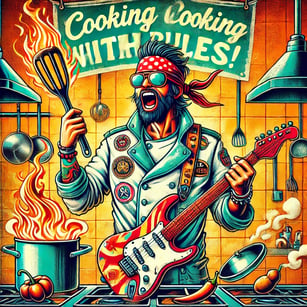

The Rebel Chef:
Leading the Culinary World
by Breaking the Rules
Steve Weiss, ACC
Transformational Leadership Academy
Tradition is a cornerstone of the culinary world, but every so often, a chef emerges who dares to challenge norms, redefine excellence, and inspire change. These rebel chefs don’t just cook—they lead with purpose, boldness, and innovation. This article explores real-life examples of rebel leadership in the kitchen and how chefs can apply these principles to inspire their teams and transform their craft.
1. Question the Recipe
Rebel chefs challenge conventions and rethink traditional practices, often redefining entire cuisines or creating new culinary genres.
Example:
René Redzepi, head chef at Noma in Copenhagen, questioned the reliance on imported ingredients and popularized the concept of New Nordic Cuisine. By focusing on hyper-local, seasonal ingredients, he transformed the culinary landscape and earned Noma the title of “World’s Best Restaurant” multiple times.
How to Apply It in the Kitchen:
Challenge your team to source ingredients locally and create dishes that reflect your region’s identity.
Host menu development days where the team reinvents a classic dish with unconventional techniques or flavors.
Ask “What if?”: What if we served this dish raw? What if we plated it differently?
2. Fail Faster, Cook Smarter
Rebel chefs embrace failure as part of the creative process, viewing mistakes as opportunities for growth.
Example:
Massimo Bottura, chef-owner of Osteria Francescana, created one of his most famous dishes, “Oops! I Dropped the Lemon Tart,” after a kitchen mishap. Instead of discarding the broken dessert, Bottura reimagined it as an artistic statement, celebrating imperfection. The dish became iconic and exemplified his philosophy of turning mistakes into triumphs.
How to Apply It in the Kitchen:
Conduct “fail tastings,” where the team analyzes unsuccessful dishes and brainstorms how to improve or repurpose them.
Share stories of your own culinary failures to normalize experimentation.
Celebrate bold ideas, even when they don’t work, to build a culture of innovation.
3. Cook with Purpose, Not Perfection
Rebel chefs lead with a vision that goes beyond the plate, inspiring their teams and creating a deeper connection with diners.
Example:
Alice Waters, the founder of Chez Panisse in Berkeley, California, pioneered the farm-to-table movement, emphasizing sustainable, organic agriculture. Her purpose-driven leadership reshaped how chefs source ingredients and advocate for environmental stewardship.
How to Apply It in the Kitchen:
Partner with local farms to showcase their produce on your menu.
Highlight your purpose in your restaurant’s branding and storytelling.
Organize team outings to farms, fisheries, or markets to connect your team to the sources of their ingredients.
4. Build a Brigade, Not a Pyramid
Rebel chefs focus on collaboration rather than rigid hierarchies, empowering their team to take ownership and contribute to the creative process.
Example:
Grant Achatz of Alinea in Chicago revolutionized his kitchen by fostering a collaborative environment where cooks at all levels are encouraged to pitch ideas. This approach has led to groundbreaking dishes and consistent innovation, earning Alinea multiple Michelin stars.
How to Apply It in the Kitchen:
Create an “idea wall” where team members can post suggestions for dishes or techniques.
Rotate leadership during service to give each team member experience in managing the pass.
Celebrate individual contributions, whether it’s a perfectly executed sauce or a creative garnish idea.
5. Push the Culinary Comfort Zone
Rebel chefs thrive on bold risks, introducing new ingredients, techniques, and concepts that challenge diners and inspire teams.
Example:
José Andrés, founder of ThinkFoodGroup, introduced Americans to Spanish tapas when small plates were virtually unheard of in the U.S. Later, he pushed boundaries further by using molecular gastronomy to create playful, surprising dishes like “olive spheres” that explode with flavor.
How to Apply It in the Kitchen:
Experiment with unfamiliar ingredients or techniques during team training sessions.
Create a special “chef’s choice” tasting menu that allows your team to explore bold, creative ideas.
Collaborate with chefs from other cuisines to infuse new perspectives into your menu.
So, Find Your Inner Rebel!
The culinary world needs rebel chefs—leaders who challenge the status quo, embrace failure, and push boundaries to create something extraordinary. By questioning the recipe, cooking with purpose, fostering collaboration, and stepping outside the comfort zone, you can inspire your team and transform your craft.
What now?
What’s one rule in your kitchen that’s ready to be broken? Take the first step today—and lead your brigade into a bold, delicious future!
Contact Info
steve@leadwithtla.com
216-288-4548
